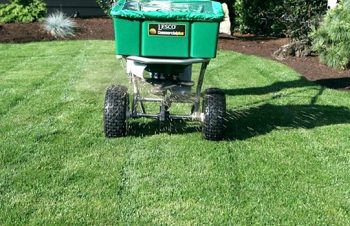 We all know that every living thing needs proper nourishment in order to thrive. This is why the Sod Gods encourage you to follow an effective fertilizing schedule for your lawn. Whether you’ve got an established turf or a newly laid bed of sod, adequate nutrition is key to a healthy lawn.
We all know that every living thing needs proper nourishment in order to thrive. This is why the Sod Gods encourage you to follow an effective fertilizing schedule for your lawn. Whether you’ve got an established turf or a newly laid bed of sod, adequate nutrition is key to a healthy lawn.
Fostering Healthy Growth
Did you know that newly planted grass needs extra fertilization to be sure the blades take root and establish themselves in the topsoil? No matter when you’ve planted seeds or laid new sod, it’s important to apply fertilizer 4 to 8 weeks afterward, in order to encourage deep growth.
In addition to newly sprouted grass, another prime growth season for your lawn is mid to late May. The weather is warm, we’ve had a few Spring showers, and your grass is soaking up the light of longer days. This is an ideal time for fertilizer application, as the grass- and other plants in your yard- will optimize the nutritional boost during the Springtime growth spurt.
How to Fertilize
For grass seeds, you want to work the fertilizer into the soil with a tiller, but no deeper than about 4 inches. To care for sod grass or an established turf, you can use a seed spreader or drop spreader for even distribution of solid fertilizer. When using a solid, make sure you water your lawn shortly afterward, to ensure the soil saturates the nutrients.
There are also many liquid fertilizers you can affix to your hose to broadcast throughout the yard while manually watering your grass. You’ll also want to keep pets and children off the lawn for 1-2 days fertilizing, to avoid chemical exposure.
Did you know that different grass types require different ratios of nitrogen, potassium, and phosphorus? The Sod Gods have more information for you about properly caring for your specific breed of turf.
When to Fertilize
Most grasses need fertilizing 5 to 8 times per year, and it’s important to know which times of year are best for this task. In the North Texas region, you want to avoid fertilizing during the hottest times of year so you don’t risk chemical burns. May and September are ideal times due to their moderate temperatures, so long as your area isn’t regularly reaching highs above 90*F.
Just like you want to avoid excessive heat, it’s equally unwise to fertilizing during extreme cold. You don’t want to waste valuable nutrients that will only freeze in a cold snap. Moderate weather conditions increase the likelihood of optimal absorption into the soil and root system.
Best practice is to pay attention to you local weather patterns, and fertilize throughout the cooler months during times when you aren’t facing a winter freeze. As always, if you’re unsure when or how frequently to fertilize, it’s best to consult a lawn care professional for expert advice.
Natural Nourishment
Keep in mind that, when you mow, you want to leave the clippings in the lawn rather than using a bag mower. This is a fantastic way to redistribute valuable nutrients to your grass. As the clippings break down from heat and water exposure, the minerals soak into the soil and get reabsorbed by the grass roots.
Fertilizing your grass is essential to maintaining a lush and healthy landscape. But it’s only one of many steps in effective lawn care. Read more useful advice about how to take great care of your yard.
